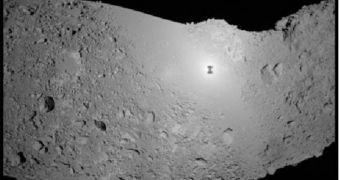For many years, astronomers and engineers at various space agencies have been working towards achieving a very challenging goal – conducting a successful sample-return mission to a nearby asteroid. This June, the Japanese space agency JAXA could become the first to actually pull this off. Its battered Hayabusa space probe is currently on its way back after meeting up with the small, potato-shaped asteroid Itokawa, back in 2005. It is scheduled to drop a small canister containing the samples it collected from the surface of the space rock in the Australian outback, in only two months' time.
Over the last five years, the small probe has suffered numerous glitches in various systems, which made its controllers almost call it quits on several occasions. However, the spacecraft proved to be more resilient than anyone thought, and engineers managed to patch things up from the ground sufficiently well to grant Hayabusa a fighting chance of reaching Earth. At this point, it is basically “limping” its way back home, but JAXA officials are convinced that it will eventually make it.
This June, the probe is scheduled to pass close enough to Earth to eject a small capsule, containing the sample canister. This component is scheduled to land in the South Australian outback, at the Woomera Prohibited Area. The facility is the largest test range in the world located on land, and is under the jurisdiction of the Australian Department of Defense. Its territory was agreed upon as a landing site for Hayabusa's samples in a document Australia and Japan signed a while back. “Australia is proud to support Japan in this world-first expedition,” explained recently Australia's Minister for Innovation, Industry, Science and Research, Senator Kim Carr.
In addition to being on the verge of making history as the first successful sample-return mission to an asteroid, the Hayabusa spacecraft is also the first probe to have ever lifted off from a space rock. In late 2005, the machine had to make an unplanned landing on the surface of Itokawa, due to a glitch. It spent about half an hour on the rock, and then blasted off for a return trip home. In addition to the dust and pebbles its sample canister may contain, the probe also collected some 15,000 data points, using its X-ray spectrometer, about 120,000 near-infrared spectral data, as well as 1,600 pictures of the asteroid.
“Australian authorities will assist JAXA in ensuring the recovery of the spacecraft on its return and are working closely with their Japanese counterparts on the proposed path and landing of Hayabusa. This has been an historic mission. It is the first time a spacecraft has made contact with an asteroid and returned to Earth,” added John Faulkner, who is the Australian Minister for Defense, quoted by Space.

 14 DAY TRIAL //
14 DAY TRIAL //